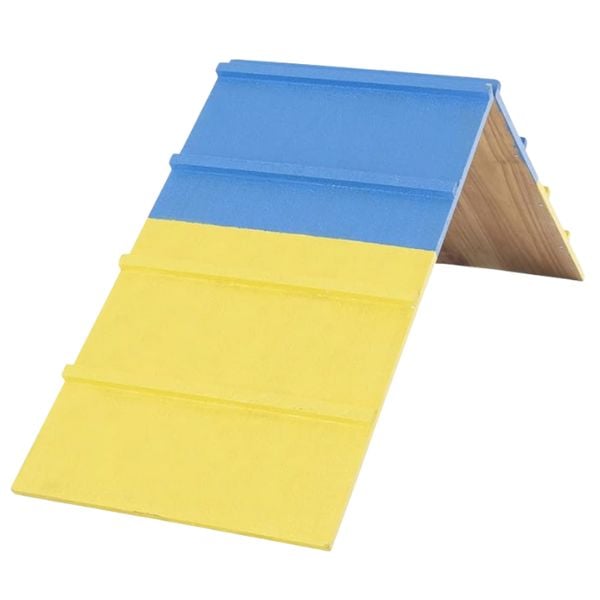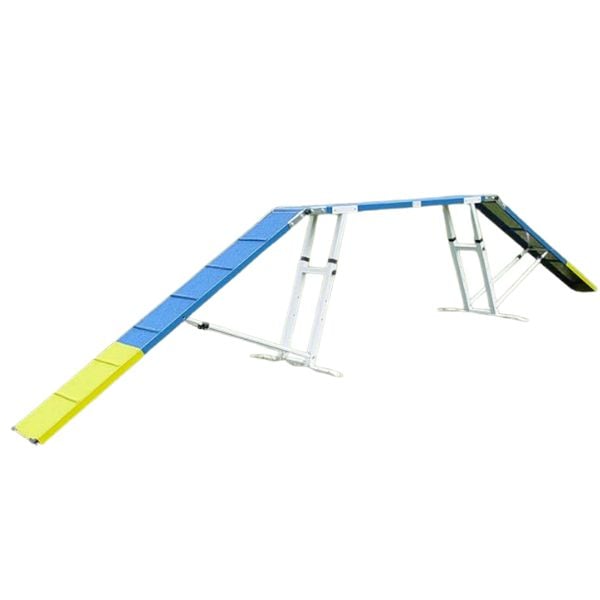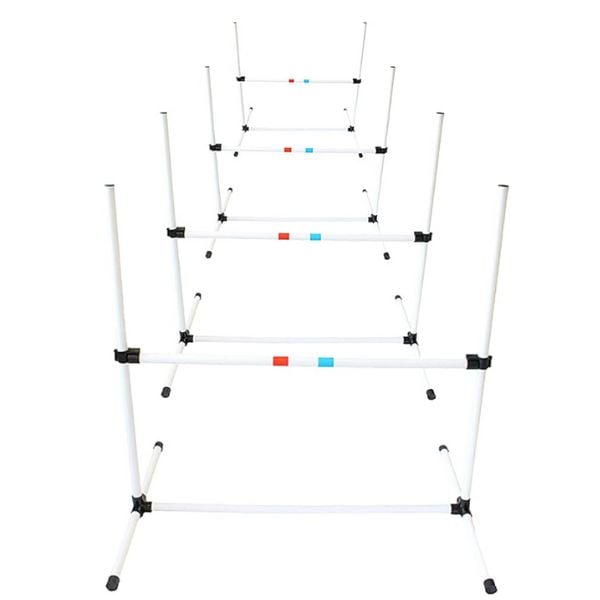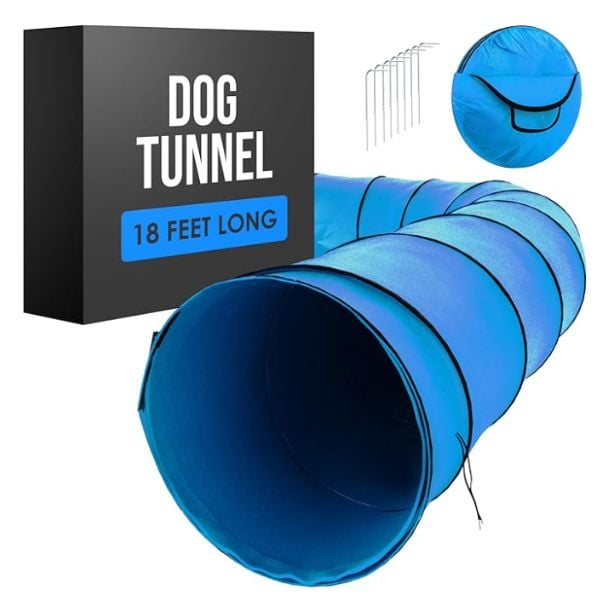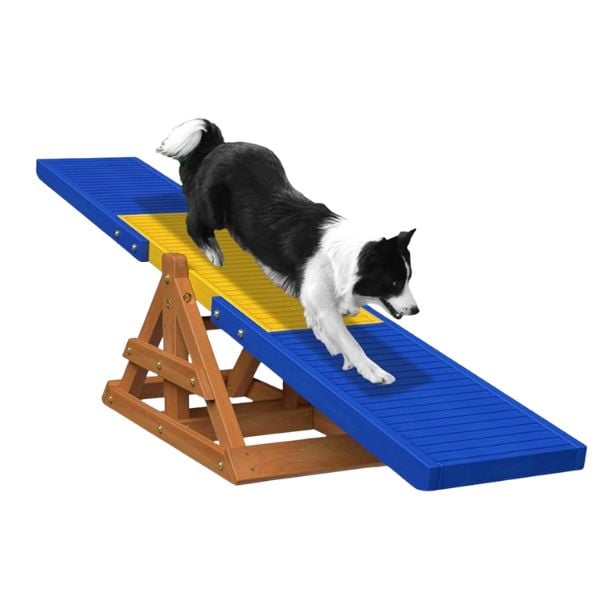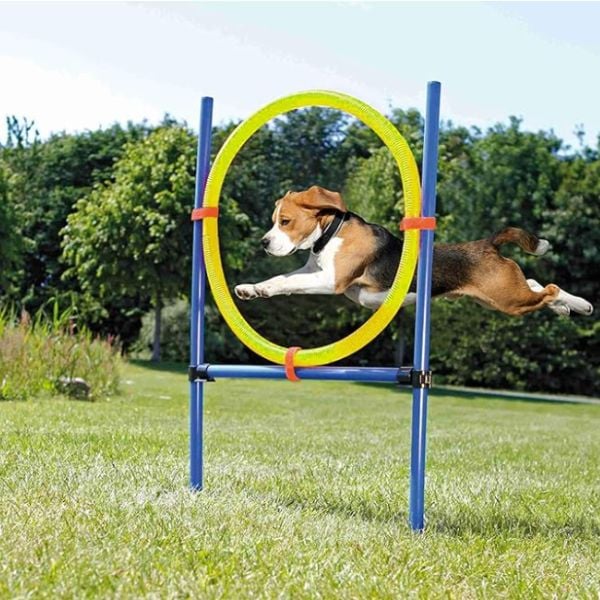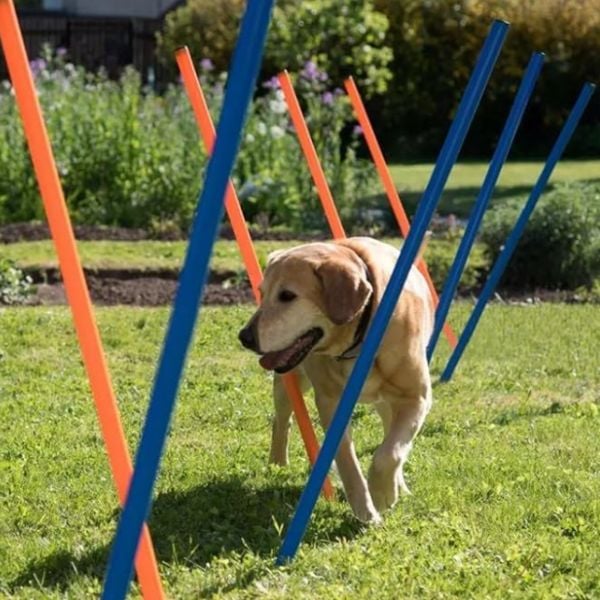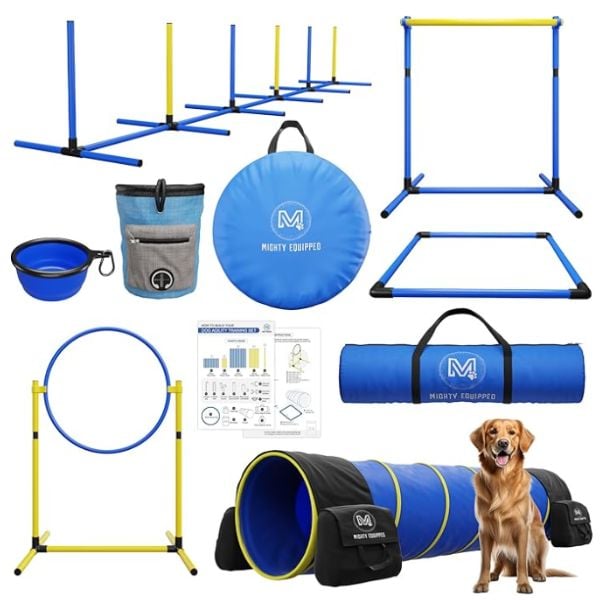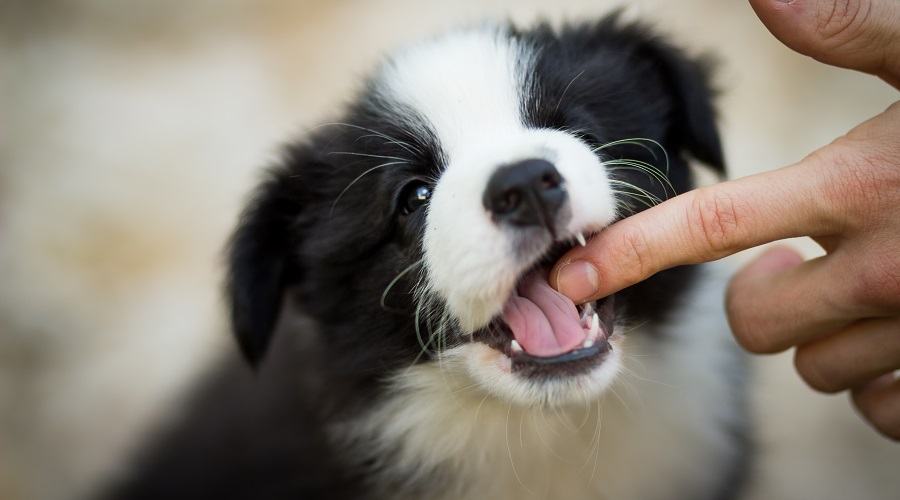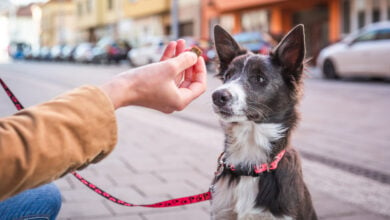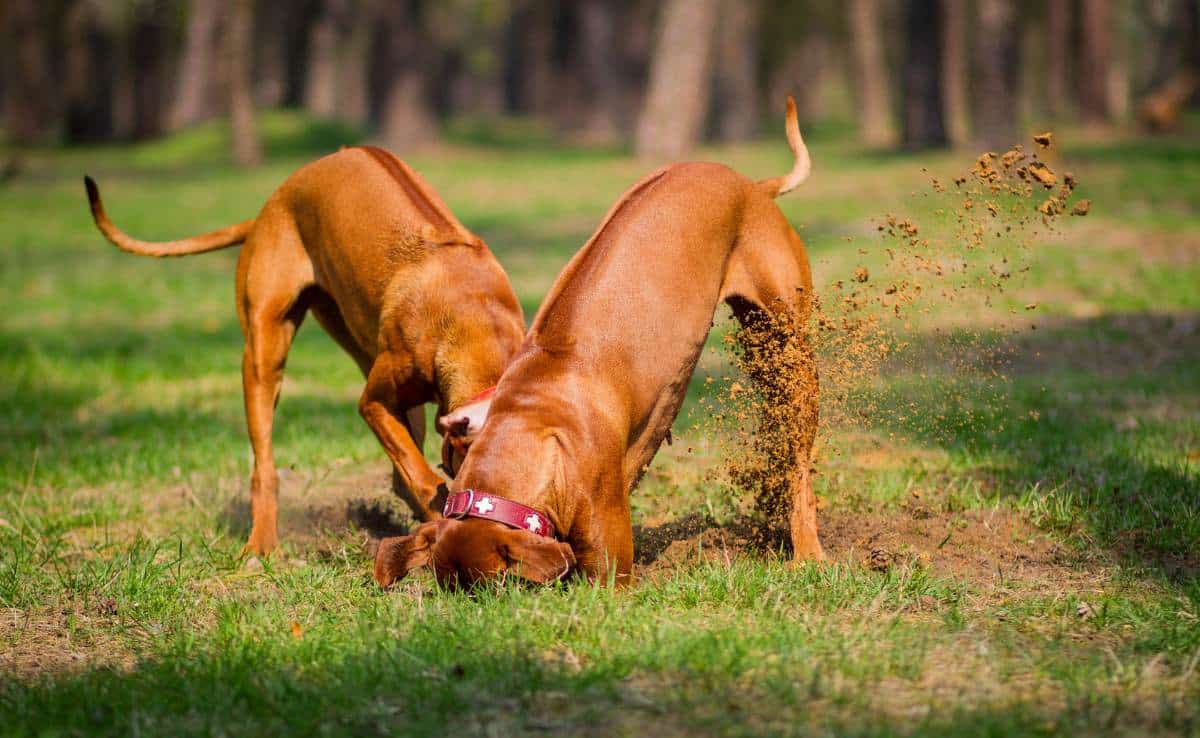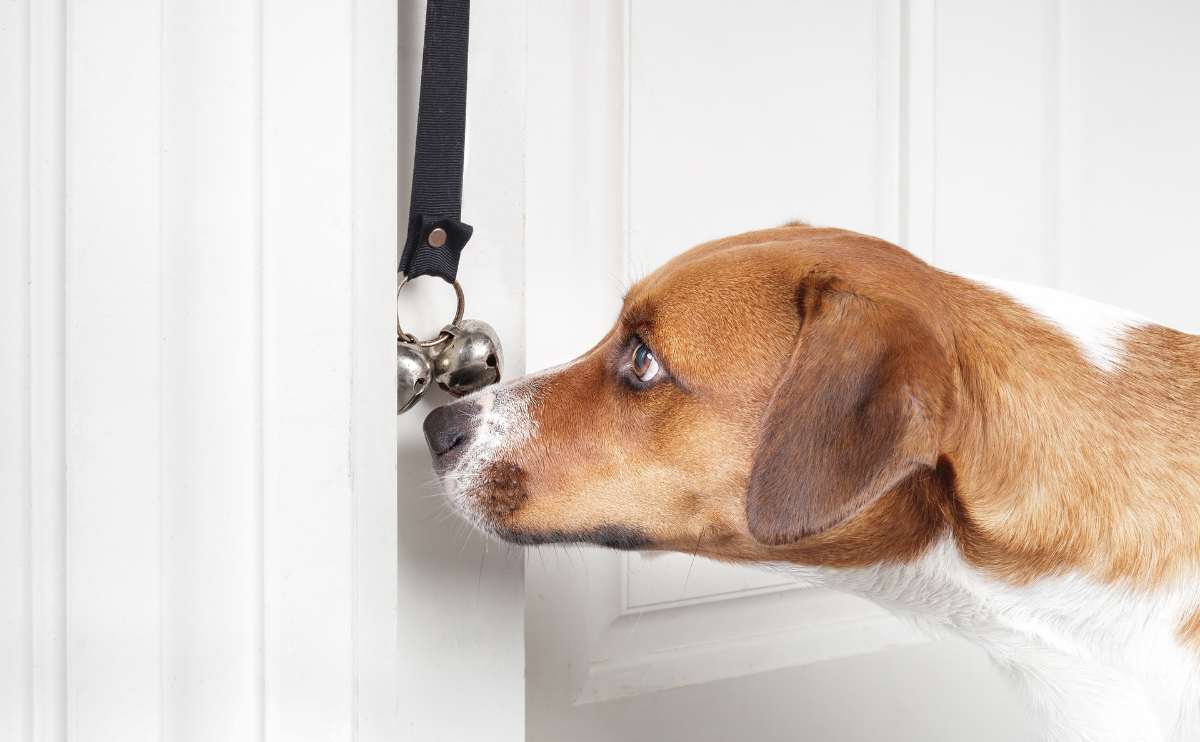Dog Agility Training: Turn Your Chaos Goblin Into A Backyard Athlete
When you purchase through links on our site, we may earn a commission. Here’s how it works.
Your dog’s got Olympic energy and zero boundaries. Couch parkour? Elite level. Zoom call sock theft? Unmatched. And somehow, they’re still not tired. That’s where dog agility training comes in.
Table of Contents
It turns all that unhinged energy into something useful (and honestly, pretty impressive). Think obstacle courses, brain-boosting challenges, and backyard fun that doesn’t involve destroyed pillows or frantic vet visits.
No fancy trainer needed. No big budget. Just a few simple setups, some treats, and a dog who’s ready to jump, weave, and show off.
What Is Dog Agility Training?
If your dog sprints into walls for fun or turns the backyard into a one-dog demolition derby, congratulations. You’ve got prime agility material.
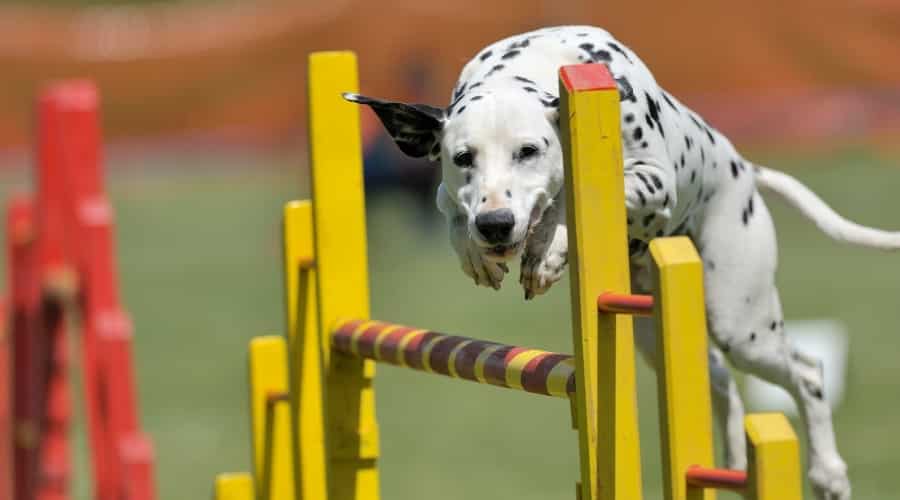
Dog agility training is a structured sport where dogs race through obstacle courses filled with jumps, tunnels, weave poles, and more. But here’s the twist: they’re not just running wild. They’re following your lead.
It’s physical exercise and a mental workout, like CrossFit meets Simon Says, but with more drool and way better vibes. It’s also an excellent bonding exercise.
Originally designed for high-energy working breeds, agility is now for every dog with legs, motivation, and a little chaos in their soul. From tiny Chihuahuas to wobbly-legged seniors, agility courses can be scaled, simplified, and made fun at home, with no competitions or trainers required.
3 Dog Agility Training Exercises For Beginners
Before you go Googling “$300 agility tunnel,” slow your roll. The best part about dog agility training for beginners is that you can start right now, at home, for free, using stuff you already have lying around.
Seriously. No fancy gear, no fenced-in arena, and definitely no whistle required. All you need is a little space, some training treats, and a dog that’s currently bouncing off the walls.
Try these three low-effort, high-fun exercises to test your pup’s agility potential and start building focus, confidence, and coordination, without spending a dime.
1. Jump The Broomstick
Equipment needed: A broom + two shoeboxes, bricks, or stacked books
Lay a broomstick across two objects to make a mini hurdle, or use a bench. Start very low, barely off the ground, and encourage your dog to hop over with a treat, toy, or gentle lead.
Got a skittish dog? Step over it yourself first, or toss a treat just beyond the “jump.” Most dogs will follow the food before they even realize they’re training.
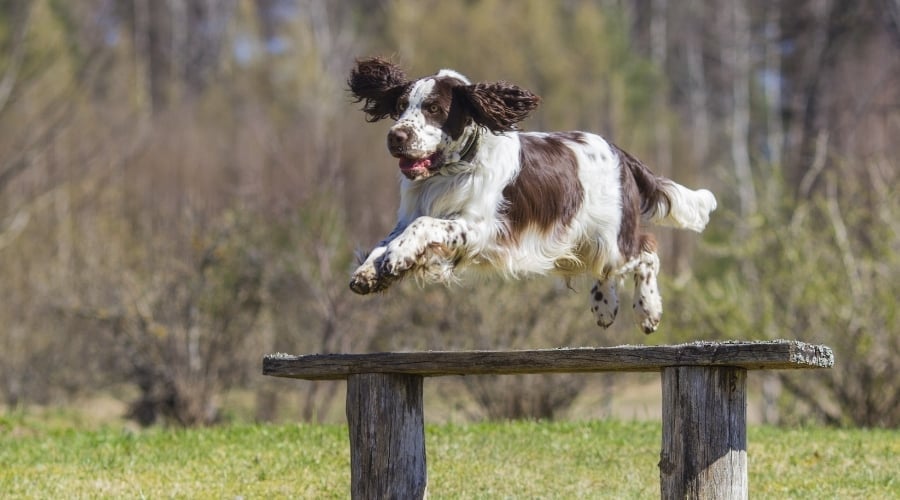
2. Tunnel of Zoom
Equipment needed: A kid’s play tunnel, a large cardboard box, or two chairs + a blanket
Create a short tunnel using household items. Use a treat trail or their favorite toy to coax them through. Don’t rush it. Let them sniff, peek, and go at their own speed.
3. Weave It Like Beckham
Equipment needed: Water bottles, solo cups, or shampoo bottles. Basically, anything upright and lightweight
Line up 4–6 items in a row and lure your dog in a zig-zag pattern with a treat or toy. Go slow, reward small wins, and repeat. It builds impressive body control and patience (for both of you).
This engages your dog’s brain more than just sprinting around, perfect for rainy days or short attention spans.
Ready to Level Up?
Once your pup gets the hang of these beginner moves, you’ll probably want to upgrade from broomsticks and shampoo bottles to real agility gear. Don’t worry, it’s way more affordable (and fun) than you’d think.
Teaching Dog Agility At Home
If the broomstick jump is now your dog’s favorite sport and they’ve mastered the “tunnel of zoom,” it’s time to upgrade your chaos goblin’s training grounds.
Good news: you don’t need to drop big bucks or turn your yard into a doggie theme park. These budget-friendly agility tools are portable, easy to set up, and way more durable than your dining chairs and throw blankets.
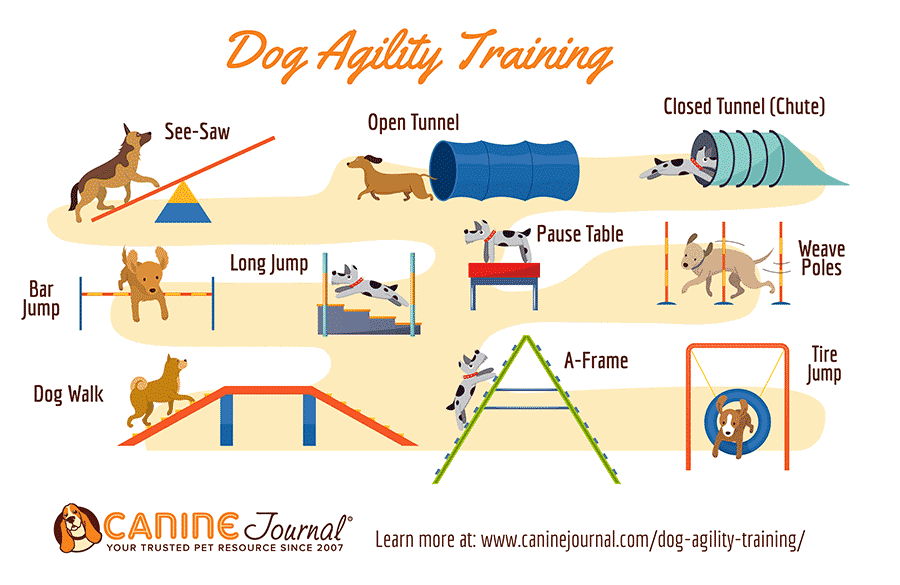
You don’t need all the bells and whistles of a competition-level course to get results. But knowing what the pros use will help you choose the right equipment to keep things challenging, fun, and safe.
Most professional agility courses have between 14 and 20 obstacles, but you can build confidence and skills with just a few core pieces at home.
Here are the most common types of agility equipment and how each one can level up your dog’s training.
1. A-Frame
The A-frame consists of two wide ramps joined at the top to form a peak. Dogs run up one side and down the other. This obstacle builds climbing confidence, balance, and focus.
It also challenges your dog’s coordination as they adjust to the incline and height. Many A-frames come with grippy surfaces to ensure safe footing.
The Better Sporting Dogs Agility A‑Frame is a sturdy, no-tools-required ramp that gives your dog a real agility challenge and pro setup. The non-slip surface and wide platform help build climbing confidence safely, even for first-timers.
I recommend it because it’s safe, durable, easy to assemble, and the perfect next step once your dog’s ready to graduate from flat-ground obstacles.
2. Dog Walk
This is a narrow, three-part structure consisting of an incline ramp, a flat center, and a decline ramp. It tests your dog’s balance and control as they move along the narrow path.
The dog walk is great for teaching precision foot placement and slower, controlled movement compared to the speed of jumps or tunnels.
If you’re ready to take your dog’s training to the next level, this Aluminum Dog Walk from the Dog Sport store, featuring a rubber surface, is one of the safest and most durable options available. Unlike flimsy DIY setups, it provides a stable, non-slip surface that helps build your dog’s confidence while keeping them secure.
It’s lightweight but sturdy, easy to assemble, and the rubber coating helps prevent slips, especially for beginners who are still learning how to control their footing. I recommend this one because it combines professional-grade quality with at-home usability.
3. Jumps
A simple bar suspended between two vertical stands. These are often adjustable in height, allowing you to start at a low level and increase the difficulty as your dog progresses.
Jumps build confidence, strengthen muscles, and encourage your dog to focus on timing and takeoff. They’re a staple in every agility setup.
These Midlee Adjustable Dog Agility Jumps are ideal for beginners who want a flexible and lightweight setup that grows with their dog’s skills. The height adjusts easily, so you can start low and build confidence without risking injury.
They’re easy to set up, take down, and store, ideal for small yards, driveways, or even indoor practice. I recommend this set because it’s affordable, beginner-friendly, and gives you the kind of clean, consistent jump practice that makes a real difference in your dog’s progress.
4. Open Tunnel
A long, flexible canvas tube that can be set up in a straight line or curved into different shapes. Tunnels are excellent for speed training and boosting a dog’s confidence in tight spaces.
They also help teach follow-through, as your dog must commit to running through even when they can’t see the exit.
This Houseables Dog Agility Tunnel is one of the best starter tunnels for backyard training. It’s lightweight, durable, and long enough to challenge your dog without overwhelming them. The polyester material holds up well to repeated runs, and the stakes help keep it securely in place during those wild zoomies.
Whether you’re just starting out or adding to an existing course, I recommend this tunnel because it strikes the perfect balance between fun, function, and price.
5. Seesaw (Teeter Totter)
Similar to a child’s seesaw, this piece pivots in the middle. As your dog walks across, their weight causes it to tip. The motion introduces dogs to shifting surfaces, which improves balance and bravery. It’s one of the more advanced tools, as the movement can startle less confident dogs, so go slow.
This SuniBoxi 95″ Wooden Dog Agility Seesaw is a game-changer for home training. You’re getting a full-length teeter that can support up to 200 lbs, making it ideal for dogs of all sizes. The solid wooden plank is durable and weather-resistant, while its non-slip surface helps dogs feel secure the moment they step on it.
Assembly is straightforward, and it stores flat, so it won’t occupy your entire yard. I recommend this seesaw because it delivers serious training value, balance, confidence, and coordination, without breaking the bank or risking safety.
6. Tire Jump
A suspended, donut-shaped ring that dogs must leap through cleanly. It requires precision and body control. Unlike regular jumps, the enclosed shape means dogs can’t simply step over or under it; they must aim and commit to it. It’s a fun way to challenge more confident jumpers.
This Pet Prime Ring Jump is a sleek and compact way to mix up your dog’s home agility routine. The durable hoop is designed to stay securely in place while your chaos goblin learns to jump through it with aim and confidence.
It’s easy to assemble and light enough to move around the yard or even indoors, allowing you to keep training dynamically and have fun. I recommend this ring jump because it adds variety, builds precision, and fits seamlessly with beginner-friendly backyard setups.
7. Weave Poles
A line of upright poles, usually in sets of 6 to 12, spaced evenly apart. Your dog must weave in and out of each pole in sequence. This is one of the most mentally demanding exercises in agility. It teaches focus, flexibility, and body awareness while also providing a solid physical workout.
This PAWISE 12 Weave Poles Set is perfect for dogs ready to step up their agility game. With more poles than most starter kits, it allows for longer, more challenging weaving sequences that improve your dog’s focus, flexibility, and precision.
The set comes with ground stakes for stability and is easy to set up in grass or soft soil. I also recommend this one for trainers who want a reliable, budget-friendly way to practice a core agility skill with room to grow, especially if your dog has already mastered shorter setups.
8. Dog Agility Training For Beginners Starter Kit
If you’re ready to go all-in on agility without breaking the bank, the MIGHTY EQUIPPED 7‑Piece Dog Agility Starter Set gives you everything you need to begin, including a tunnel, jump bar, weave poles, cone markers, and various connectors for layout flexibility.
Each piece is made with durable materials and comes with ground anchors and a carrying bag for quick setup and tidy storage. It’s a fantastic choice for beginner to intermediate dogs who love the homemade drills and are ready for a more structured course.
I recommend this kit because it strikes a balance between variety, quality, and portability, offering full agility fun at everyone’s favorite price point.
Agility Fails Are Inevitable: What To Expect Early On
Let’s get one thing straight: your dog is probably going to mess this up a lot.
They’re going to walk around the jump instead of over it. Sit down halfway through the tunnel and refuse to move. Casually knock over every weave pole like it’s a bowling lane. This is normal. This is training. And honestly? It’s part of the fun.
Agility isn’t about instant perfection. It’s about building confidence, coordination, and communication, slowly, with lots of snacks and laughter along the way.
Every “fail” is a chance for your dog to figure things out and for you to bond through the chaos. Here’s what most beginners experience in the first few sessions:
- Tunnel hesitation: Your dog peeks in, sniffs, and walks away like you’ve just offered them a trap.
- Jump confusion: Instead of jumping over the bar, they run around it, under it, or try to chew it.
- Weave pole chaos: They either bulldoze through like a tank or stare at you like, “You want me to do what now?”
The key is to keep it light. Celebrate tiny wins, like just touching the tunnel with a paw. Lower the bar (literally) if they’re not ready. And always end on a positive note, even if the only thing your dog “nailed” was sitting for a treat.

Agility training is supposed to be messy. That’s what makes it real, and what makes it so rewarding when your dog finally nails that jump or zips through the tunnel like a four-legged rocket.
Film your early sessions. You’ll get cute videos, funny fails, and visible progress over time, which is wildly satisfying.
How to Motivate a Lazy Dog to Try Agility: 5 Ways
Not every dog has zoomies. Some nap professionally. If your pup’s idea of cardio is rolling over mid-snore, don’t worry, agility training isn’t just for high-energy breeds. It can be just as effective (and fun) for slower, more stubborn, or “why bother?” types, with the right approach.
The trick? Make agility feel like a game, not a job. Lazy or laid-back dogs require extra motivation, shorter sessions, and plenty of encouragement to adopt this new routine. Here’s how to win them over:
1. Use Their Favorite Reward
Food is the universal motivator for dogs, but get specific. Use high-value treats they only get during training (think: chicken bits, string cheese, or that one treat that makes them lose their mind). You can also use toys or praise, whatever gets that tail wagging.
2. Keep Sessions Ultra Short
Five minutes of training is better than 30 minutes of frustration. Start with a single jump or short tunnel run, and call it a win. Quit while they’re still interested, so they come back excited next time.
3. Start With The Easiest Win
Let them walk around obstacles, touch equipment, or just explore the space first. Don’t expect perfect runs. Build familiarity and confidence slowly.
4. Praise The Effort, Not The Performance
If your dog walks through the tunnel like it’s a runway? Celebrate. If they knock over every weave pole but make eye contact? Throw a treat party. They’ll associate agility with success, not correction.
5. Schedule Around Their Energy
Catch them right after a walk? Probably not the best time. Find their “alert window”, that 15-minute window when they’re awake and nosy, and use it to your advantage.
Quick Note: Older, overweight, or chill-breed dogs can absolutely do agility. You just need to go slower, lower, and celebrate louder.
Agility isn’t about turning your Bulldog into a Border Collie. It’s about movement, bonding, and enrichment, even if your dog’s main sport until now has been napping in sunbeams.
2 More Tips for Teaching Dog Agility at Home
Most at-home agility setups don’t require all of these elements. Starting with just two or three, like jumps, a tunnel, and weave poles, can keep things fresh and help your dog build skills without getting overwhelmed.

Agility isn’t about perfection; it’s about progress. A few well-chosen pieces of gear can transform your training sessions from “just trying to tire them out” into something structured, rewarding, and surprisingly fun.
1. Dog Agility Training Commands
Before working on dog agility training at home, you’ll want to master basic obedience commands (i.e., sit, lie down, stay, come, heel). It’s also beneficial to practice these commands around other dogs, so enrolling in an obedience class with others can be helpful.
Once your dog has mastered basic obedience, you can learn how to introduce your dog to agility.
2. Watch Others
Another tip is to watch videos of dog agility competitions online or go to local trials in your area to become more familiar with how the sport works. You could even volunteer to get a closer, behind-the-scenes look and learn more about the requirements of the sport.
Once you decide that agility training for your dog is something you both enjoy, you may be ready to take things more seriously and sign up for an agility class.
Check out this quick video from the Kennel Club on how to get started in agility training.
6 Injury Prevention Tips For Agility Dogs
Agility is fun, but it’s also a sport. And just like people, dogs can pull muscles, tweak joints, or overdo it if they jump straight into intense training. The good news? Most injuries are totally preventable with a few smart precautions.
Whether your pup is a zoomie-prone beginner or a confident course runner, here’s how to keep agility safe, sustainable, and vet-approved:
1. Warm Up First
Let your dog walk or trot around for 5–10 minutes before training. A quick warm-up gets blood flowing and reduces strain on cold muscles, just like it does for us.
2. Start Low, Build Slow
Don’t max out jump heights or weave speeds right away. Let your dog build strength and coordination gradually. Progress over weeks, not days.
3. Watch The Surface
Avoid hard or slippery surfaces, such as tile, pavement, or wet grass. Grass, turf, or rubber mats offer better traction and joint protection.
4. Use Proper-Sized Equipment
Make sure jumps, tunnels, and ramps are scaled to your dog’s size and skill level. Using gear that’s too high or unstable is a fast track to injuries.
5. Limit Repetitions
Agility is exciting, but also tiring. Keep sessions short (5–15 minutes), especially with younger or older dogs. Overtraining leads to burnout and strain.
6. Know When To Stop
If your dog starts hesitating, slowing down, or losing interest, take a break. Limping, stiffness, or paw-licking afterward? Skip the next session and consult with your veterinarian if the issue persists.
Consult your veterinarian before starting if your dog is overweight, recovering from an injury, or has joint issues such as hip dysplasia. A simple check-in can save you both a lot of trouble later.
Agility should energize your dog, not exhaust them. A smart pace and a few precautions go a long way in keeping your training safe, fun, and sustainable for the long haul.
How To Find Agility Classes For Dogs: 2 Options
It’s best to start agility training your dog early to help them acquire the new skill, but it’s never too late to pick up a new hobby. Agility classes are the best way to learn the proper sporting techniques.
Most dogs begin competing in agility competitions between one and two years old. However, don’t feel pressure to compete in the sport. Backyard courses and classes can provide just as much fun and exercise for your dog.
You have a couple of options for professional classes.
1. Online Dog Agility Training
If you prefer to do agility training at home for dogs, you could try SpiritDog’s online class. This dog agility program shows you how to build hurdles with PVC, teach your dog to jump, run through courses, and more. There are over 100 video lessons and dozens of PDFs for you to use.
SpiritDog’s online course may be a good fit for those interested in trying out dog agility at home. You can go through the video lessons at your own pace without worrying about making it to class on time. It’s also priced affordably.
2. In-Person Dog Agility Training
Your other option is to find a class in your area. If you’re unsure where to find a class, I recommend speaking with professionals in dog-related fields (e.g., vets, groomers, sitters, walkers, etc.). They can most likely inform you of your local options.
You can also read our article about dog trainers for more tips on finding one that fits your needs.
Online vs. In-Person Agility Classes: Which One’s Best?
So your dog’s loving agility, but you’re not sure if you’re teaching things right, or maybe you just want someone else to wrangle the chaos for a bit. That’s where training classes come in. But should you go online, or brave the IRL scene with a group of other confused humans and hyper dogs?
Let’s break it down.
In-Person Classes: Real-Time Help, Real-Life Chaos
If your dog needs structure and you require hands-on coaching, in-person classes can be extremely beneficial. You’ll learn timing, handling techniques, and how to better understand your dog. Plus, it’s great socialization.
Pros:
- Instant feedback from experienced trainers
- Access to full-sized, pro-level equipment
- Your dog learns to focus around distractions (aka other crazy dogs)
Cons:
- Can be pricey ($100–$200+ for a multi-week course)
- Classes fill fast in some areas
- If your dog is reactive or anxious, it can be stressful
Best for: Dogs who are ready for a challenge, and owners who want hands-on instruction.
Online Agility Programs: Train Anytime, Pajamas Optional
Online courses and video-based programs are great for building confidence at your own pace, especially if your dog gets overwhelmed in busy environments (or you do). Most include step-by-step guides, video feedback, and community support.
Pros:
- Train whenever it fits your schedule
- Replay lessons as needed
- Less pressure for anxious dogs (or introverted humans)
Cons:
- No in-person corrections if your technique is off
- Requires a little more self-motivation
- You’ll need your own equipment (or creative DIY)
Best for: Beginners, anxious pups, or anyone who wants to ease into agility without the social circus.
Still Not Sure? Try Both.
Begin with a few YouTube tutorials or a free online course to get a sense of it. If your dog responds well and you’re looking to take it to the next level, consider searching for a local club or class in your area. You can always combine both. Learn the basics online, then refine your skills in person.
The best class is the one you’ll actually stick with, and your dog will follow your energy.
Is Your Dog Built For Dog Agility Training?
You might be thinking, “My dog’s not exactly an athlete…” Maybe they’re short, senior, shy, or just more “chill potato” than “team USA.” Doesn’t matter. Agility is for way more dogs than you think, and chances are, yours is one of them.
Contrary to what you see on TV, you don’t need a Border Collie or Belgian Malinois to start agility. You just need a dog with a pulse and a snack-driven attitude.
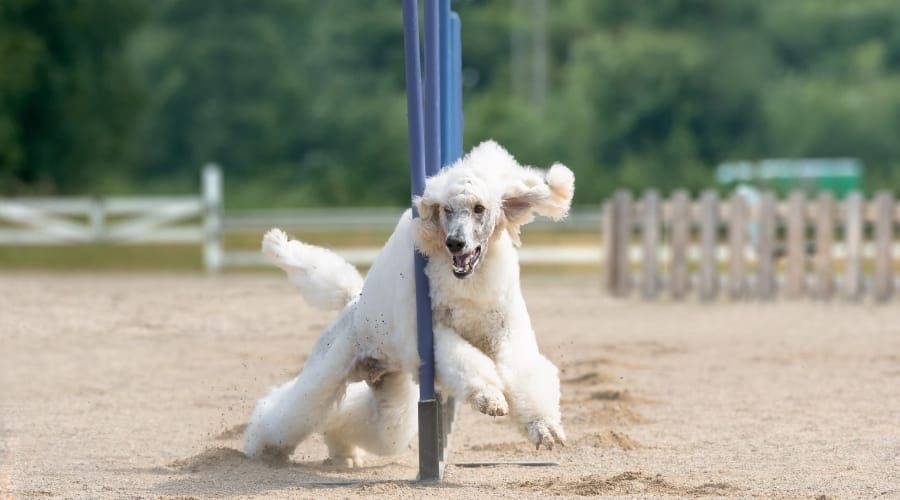
Here’s why nearly every dog can benefit from agility training:
- Small dogs? They crush agility with tight turns, speed, and sass. Bonus: the equipment is easily adjustable for their size.
- Senior dogs? Keep the jumps low and the obstacles soft. Agility can help with mobility, mental stimulation, and confidence. Just go slow and steady.
- Shy or anxious pups? Agility helps build trust and focus, especially with one-on-one time and predictable routines.
- Big or slow breeds? Yep, even your Great Dane or Bulldog can benefit. The goal isn’t speed, it’s engagement and enrichment.
Agility isn’t about trophies. It’s about bonding, movement, and giving your dog a job, even if that job is slowly weaving through solo cups for a piece of cheese.
So, is your dog “built” for agility? If they can walk, jump, and chase a treat with enthusiasm, they’re already qualified. And if you’ve made it this far, you’re the exact kind of human who can help them thrive.
Dog Agility Training FAQs
Still have questions about training your chaos goblin into an agility ace? You’re not alone. Below are answers to the most common (and totally normal) questions owners and new trainers ask when starting out.
Do you have a question we didn’t cover? Drop it in the comments.
What Age Can Dogs Start Agility Training?
Most dogs can begin agility foundation work, like tunnels and low jumps, around 6–9 months old. Save the full-height jumps and advanced obstacles until growth plates are closed, usually around 12–18 months. When in doubt, ask your vet.
Can I Train My Dog for Agility at Home Without Professional Help?
Definitely, many owners start at home with household items, a few videos, and lots of treats. Professional classes or online programs can help refine your technique, but they’re not required to get started.
What Breeds Are Best for Agility?
Agility superstars include Border Collies, Shelties, Aussies, and other working breeds. But success depends more on your dog’s drive, health, and your consistency than on their breed. Any dog can enjoy agility with the right setup.
Is Agility Training Safe for Older or Overweight Dogs?
Yes, if you scale it appropriately. Use lower jumps, softer surfaces, and shorter sessions. Agility can help with mobility, confidence, and even weight loss, but always check with your vet before starting.
How Long Does It Take to See Results?
Some dogs gain confidence in just a few sessions. Others need more time. Most owners see progress within 1–2 weeks of regular training (even just 10 minutes a day).
What If My Dog Refuses to Do an Obstacle?
It happens all the time. Break it down into smaller steps, use high-value treats or toys, and make it fun. Never force it. Let your dog build confidence at their own pace.
What’s the Difference Between Agility and Obedience Training?
Obedience focuses on commands and control. Agility is about speed, confidence, and teamwork on a course. Both build communication and focus, but agility adds more excitement (and more zoomies).
Do I Need a Big Yard to Train?
Nope. A small backyard, driveway, or even a hallway can work. Many agility drills can be scaled down or modified to fit tight spaces. Creativity is better than square footage.
What Are Contact Obstacles?
Ramp-style obstacles are known as contact obstacles because they have contact zones (painted bright yellow) that dogs must touch with one toenail or more when dismounting.
Keep the Zoomies Going: More Fun Ways to Exercise Your Dog
Loved agility? You’re just getting started. There are tons of other ways to challenge your dog’s brain and body, whether they’re a high-energy athlete or a curious couch potato.
Try barn hunt if your pup loves sniffing out critters. It’s like hide-and-seek for dogs, using safely hidden scent tubes in hay bales. Explore interactive dog toys to keep them mentally engaged indoors, such as puzzle feeders, treat balls, and tug toys, which are boredom-busting gold.
If your dog’s got drive but no direction, flirt poles are perfect; they’re like giant cat toys for dogs, ideal for practicing impulse control and burning energy fast. And when you’re tired of your own backyard, book a private field through Sniffspot, where your dog can roam, sniff, and play in a safe off-leash environment.
Tell Us: Tried a jump? Nailed a tunnel? Wiped out on the weave poles? We want to hear all about it. Drop your agility wins, fails, or funniest training moments in the comments. Whether your dog’s a rising star or still trying to figure out which end goes first, your story might inspire (or entertain) another reader!
